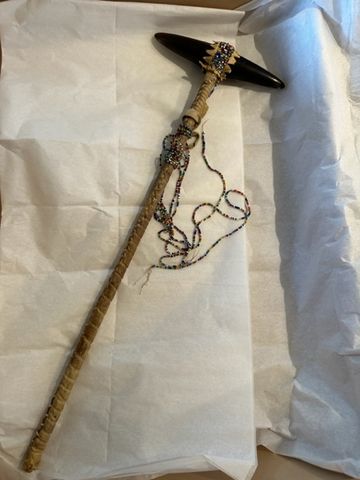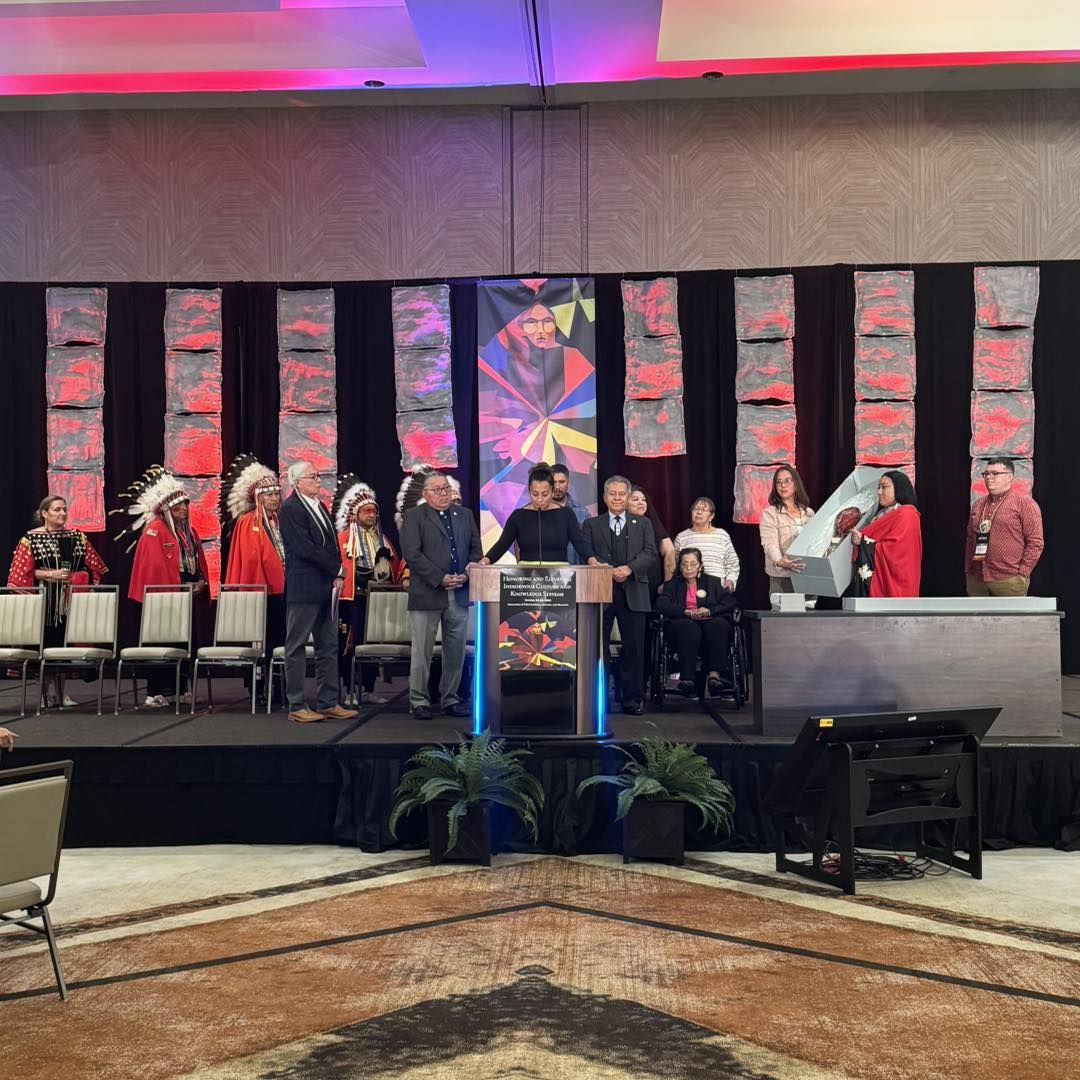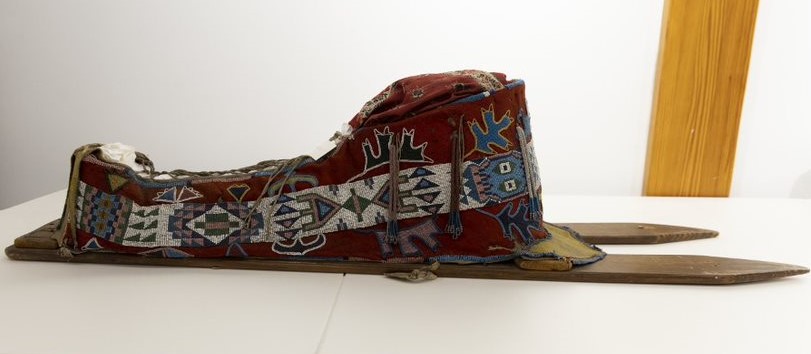“… At the National Museum of the American Indian, where I spent some time, there are remarkable earthen monuments by renowned contemporary Native artists. These pieces, situated outside the Museum, are made to return to the earth, reflecting the Pueblo culture’s view of appropriate conservation—a deep connection between our actions and the earth beneath us. Our focus at the Going Home Fund is on cultural preservation, not mere physical conservation. Each community holds unique perspectives on the treatment of objects and their significance in our shared existence, and it’s essential to respect and honor these diverse practices..” – Rick West, Chairman of the Going Home Fund and Founding Director and Director Emeritus of the Smithsonian Institution’s National Museum of the American Indian.
In July of 2023, the Museum of the Cherokee People in North Carolina sent images of 144 objects to the Association of Tribal Archives, Libraries, and Museums. These objects, including a cradleboard, were to be returned to their rightful owners. The cradleboard is a baby carrier with a flat backboard, which some Native American tribes historically used. Although delicate from years of existence, it was still as beautiful as ever and held the sacred memory of a Kiowa baby who lived over a century ago. An inscription on the back stated “Ella Ruby Onco. 1906.”
To help return the cradleboard and other items to their rightful homes, the Association of Tribal Archives, Libraries, and Museums (ATALM), a grantee co-supported by the Luce Foundation, launched a months-long process through their Going Home Fund.
“As we worked to help Native communities plan cultural facilities, we noticed a troubling trend – essential cultural artifacts were held by other institutions, creating a disconnect, and the cost and complexity of repatriation hindered progress. Our top priority became the return of these items to descendant communities, and our efforts have since expanded,” said ATALM President & CEO Susan Feller.
The fund has two important objectives. First, to provide financial aid to tribes who are trying to reclaim culturally significant items that have been held in collecting institutions like museums, universities, or private collections. And second, to support the voluntary return of these items by collecting institutions and individuals.
The Chairman of the Going Home Fund, Rick West, emphasizes its alignment with Native Futurism, a forward-looking approach grounded in acknowledging historical injustices while embracing the current existence and cultural practices of Native Peoples. Many Indigenous communities, for example, approach the future through the seven-generation principle, which guides people today to take responsibility for contributing to and creating a positive world that impacts communities’ lives seven generations into the future.
“Our focus is on developing community-based institutions such as museums and cultural centers, aiming forward while acknowledging the past’s legacy,” Mr. West said.
The Native American Graves Protection and Repatriation Act (NAGPRA) in the United States applies to a particular type of native objects, human remains, funerary materials, sacred materials, and cultural patrimony. The scope of the Going Home Fund, Mr. West explained, extends beyond traditional repatriation laws, encompassing all materials of cultural significance.
“We’re focused on facilitating the return of culturally significant materials to Native communities. This pursuit extends beyond museums, although they are typically governed by repatriation laws. Individuals too can participate in this process. Our goal is to reestablish the link between cultural artifacts and the preservation of contemporary Native culture.,” said Mr. West.

ATALM has received many donations, including a ceremonial tomahawk from an individual whose grandfather was an Indian agent – a representative of the US federal government’s involvement in the colonization of Native communities. Each item in the collection holds a significant story, but many of them are still unidentified, prolonging the process of repatriation. Some tribal museums have already repatriated items to their ancestral lands, and the Cherokee collection has nearly twenty items from South America, Costa Rica, and a few African nations, waiting to be returned to their rightful homes. ATALM is concerned that identifying some of the descendant communities will be difficult as they may no longer exist.
“We’re building a website that has photos and descriptions of the items. The website is public so cultural experts can provide guidance on objects’ cultural affiliation, provide additional context, and help direct us to the appropriate descendant community,” Ms. Feller said. “We are also working with the Waystation Project at UCLA to help identify the descendant communities of the international community, as that is out of our scope of expertise.”
On the ATALM website, a native community can request an item be returned. Once claimed, others have a 60-day waiting period to dispute the claim. After 60 days, if there are no other claimants, ownership of the item is transferred to the requesting community. Feller emphasizes the meticulous process of returning such artifacts, highlighting the substantial costs and logistical challenges.
“Transportation, packaging, and insurance are considerable expenses,” she reveals, underscoring the fund’s critical role in overcoming barriers to receiving the return of cultural artifacts.

On October 26, 2023, three months after the Museum of the Cherokee People in North Carolina contacted ATALM about the objects that needed to go home, the cradleboard (and a boy’s moccasins) were returned to a Kiowa delegation and Ella Ruby Onco’s family.
“It was emotional on everybody’s part because those kinds of returns are unexpected. For a long time, museums held and returned nothing. Fortunately, that has gone the other direction for a good thirty years now,” Mr. West reflected.
With the family’s knowledge and consent, the fragile cradleboard is now at the Kiowa Museum for care and preservation.
“We don’t tell tribes how to care for the items, and there are no mandates placed on the descendant community as to how they care for the items once they receive them. That’s up to them because some communities believe that things have a useful life, and when they exceed that useful life, then it should be no more. Should they require assistance in any way, we stand ready to provide support.,” Ms. Feller said.
ATALM provides training on culturally appropriate conservation methods and has a large library of free resources. The training isn’t specific to the cultural protocols of any one tribe but is considered general best practices.
“Our job is to focus on the question of infrastructure at the community level and figuring out how we can help communities receive or keep what is sacred to them,” Mr. West said.
Have an item that may belong to a Native community? ATALM is willing to do whatever it can to get items returned home. Fill out this intake form to share items you wish to return to a Native community.







